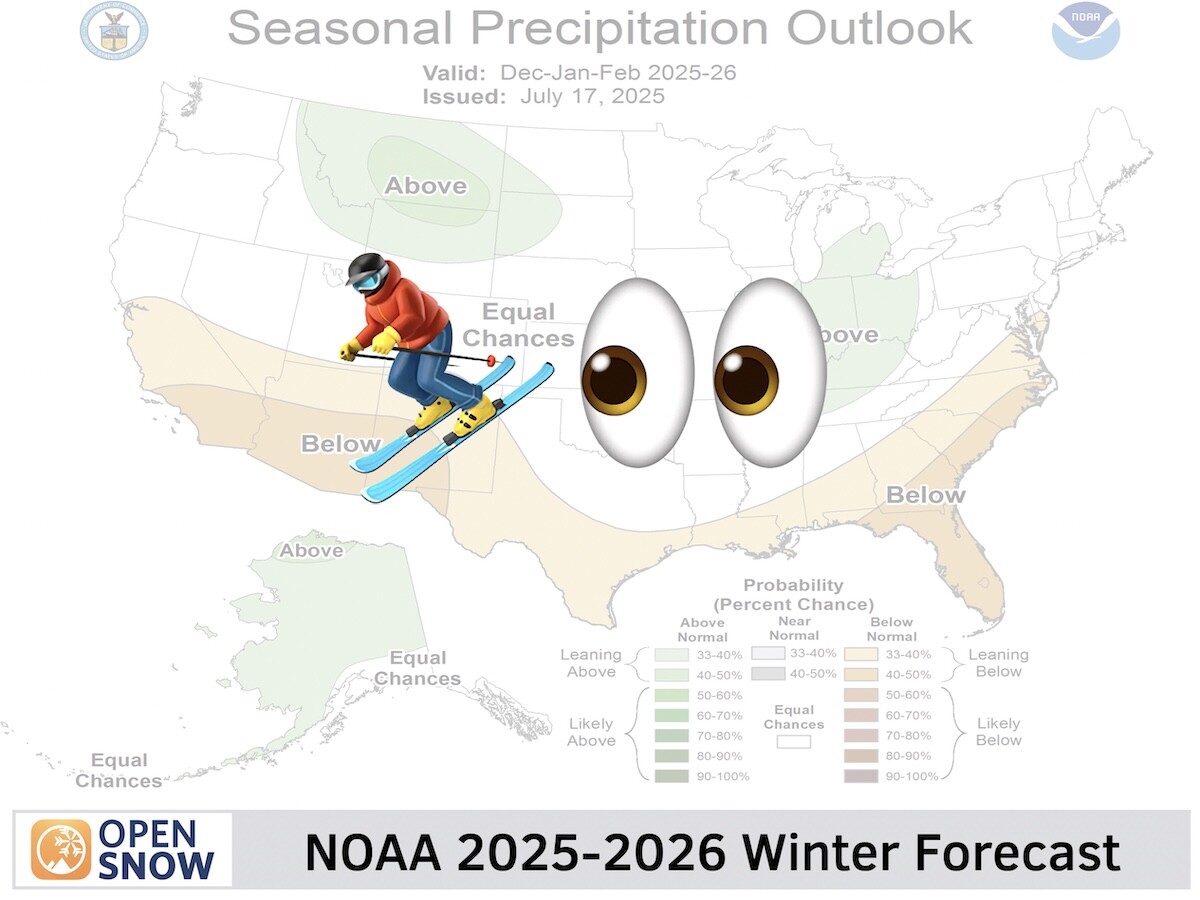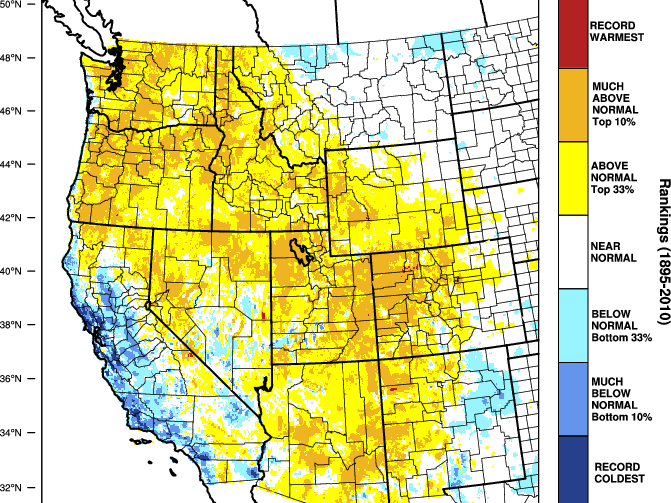News

By Alan Smith, Meteorologist Posted 3 years ago June 3, 2022
Three Key Ingredients for Mountain Thunderstorms
Thunderstorms are a common occurrence in mountain environments during the warmer months, and represent one of the greater weather hazards for hiking, climbing, and other outdoor activities.
This article explores the three key atmospheric “ingredients” needed to produce thunderstorms in the mountains: moisture, instability, and lift.
1) Moisture
Water vapor in the atmosphere – otherwise known as moisture – is a prerequisite for thunderstorm development. The more moisture available, the better in terms of thunderstorm probability, coverage, and intensity.
Typical moisture sources are oceans, which for U.S. mountain ranges, include the Pacific Ocean, Atlantic Ocean, and the Gulf of Mexico. Warmer water temperatures support higher amounts of moisture, and as a result, moisture originating from the warm Gulf of Mexico has the greatest influence on U.S. thunderstorms.
Here is a visual indicating moisture source regions for thunderstorms to develop in the U.S. While the Gulf is king when it comes to moisture supply, moisture originating from the Pacific and Atlantic Oceans (especially in the subtropics) are also viable sources for thunderstorms.

Similar to ocean temperatures, warmer air in the atmosphere can also hold a much higher capacity of moisture compared to cold air, which is one reason why thunderstorms are most common during the summer months.
Dewpoint temperature (the temperature to which air must be cooled to become saturated with water vapor) is a common variable that meteorologists examine to determine moisture availability for thunderstorms.
In the lower humidity Western U.S., dewpoints in the 40s to 50s Fahrenheit are most conducive for thunderstorms and dewpoints in the 50s can signal a threat of heavy rain and, in some cases, flash flooding. However, “dry” thunderstorms with light rainfall can occur with dewpoints in the 30s.
In the higher humidity Eastern U.S., dewpoints in the 60s and 70s are most supportive of thunderstorms, and in most cases, thunderstorm rainfall from Eastern thunderstorms is heavier compared to Western thunderstorms.
2) Instability
Atmospheric instability exists when a rising air current (also known as an air parcel) is warmer than the surrounding environment that it rises into, and as a result, will continue to rise on its own. In other words, rapid vertical motions, also known as updrafts, are encouraged when the atmosphere is unstable. The less stable the atmosphere, the stronger the updraft.
On the other hand, when the atmosphere is stable, vertical motion is inhibited and thunderstorms are unlikely.
Instability is greatest when warm, moist air exists in the lower levels of the atmosphere and colder air simultaneously exists in the upper levels of the atmosphere. Sharper declines in temperature with increasing altitude typically indicate an unstable atmosphere.
Warm air is less dense than cold air, so when a warm, moist air parcel is lifted upward, it will continue to rise into the cooler air aloft until reaching its condensation level, at which point towering cumulus clouds form and continue to expand vertically.

High amounts of moisture in the atmosphere also result in greater instability, due to the release of latent heat energy that occurs when water vapor condenses into clouds. Latent heat release further enhances the strength of an updraft.
Solar radiation from the sun is also a key driver of instability as it causes moist air parcels in the lower levels of the atmosphere to “heat up” in the first place. This also explains why thunderstorms are most common in the afternoon when the sun has had a chance to heat up the surface. Also, when thick layers of clouds are present and solar radiation is limited, this often inhibits thunderstorm development.
3) Lift, or “Trigger”
While an unstable atmosphere supports rising air currents needed for thunderstorm development, typically a lifting mechanism or “trigger” is needed to set warm, moist air currents into motion.
Thunderstorms can occasionally occur through the heating of moist air near the surface alone, but usually, more is needed as minor stable layers or inversions in the atmosphere known as “caps” are common and need some extra help to break through.
Next, we’ll go over a summary of the common lifting mechanisms that can trigger mountain thunderstorms when moisture and instability are present. Some of these lifting sources occur in the lower levels of the atmosphere, while others occur in the upper levels of the atmosphere.
Also, while a single lifting mechanism can be enough to trigger a thunderstorm, stronger and more widespread thunderstorms are likely when multiple lifting mechanisms are present simultaneously.
Orographic or Terrain-Enhanced Lift
The most obvious source of lift in mountain environments is orographic lift. This occurs when winds blowing perpendicular to a mountain range force warm, moist air to rise vertically in conjunction with the rise in terrain. This is also known as upslope flow.
In the Rocky Mountains, in particular, upslope winds in combination with solar heating often result in thunderstorms developing earlier in the afternoon compared to surrounding valleys and plains. This is especially true during monsoon season and is an important consideration when planning summit hikes or climbs.
Wind Convergence Boundaries
When winds blowing from two opposing directions converge, it causes air along these boundaries to be forced upward, resulting in rising motion.
Wind convergence often happens at the intersection of two separate airmasses, and when the convergence zones are stationary, it can result in multiple rounds of thunderstorms re-developing over the same areas.
Wind convergence can also occur as a result of wind flows being diverted around mountain ranges and through valleys or mountain passes. This can result in localized terrain-enhanced thunderstorms.
Fronts
Cold fronts are common triggers for thunderstorms and often result in organized lines of storms developing just ahead of the fronts. Storms triggered by approaching cold fronts are often strong and fast-moving.
Warm fronts are slower moving and less intense than cold fronts, but can still act as a trigger for thunderstorms and are more common in the Eastern U.S. and Appalachians compared to the West.
Stationary fronts are cold and/or warm fronts that stall over an area for an extended period of time. These can act as focal points for thunderstorm development and are essentially the same thing as wind convergence boundaries described above.
Outflow Boundaries from Thunderstorms
When a thunderstorm reaches maturity, cool/dense air and falling precipitation descend from the storm in the form of a downdraft. Upon hitting the surface, these cool air boundaries will spread outward from the ongoing storm in the form of an outflow boundary, or “gust front”.
Outflow boundaries essentially act as mini cold fronts, and can trigger new thunderstorms upon encountering warm, moist air that exists where thunderstorms have not yet occurred.
This is something to watch for in the mountains – if you see a distant thunderstorm and notice a sudden change from warm to cool/breezy conditions, then new storm development could potentially occur nearby.
Upper Air Disturbances
Larger scale weather systems, such as troughs, lead to rising motion over a larger area in the atmosphere and can act as a trigger for thunderstorm development when moisture and instability are present.
While thunderstorms are most common in the late spring and summer months, approaching troughs that move into pre-existing warm/moist airmasses can result in thunderstorms during the early spring and fall (and occasionally winter) months, especially in the Eastern U.S. when warm, Gulf air surges northward ahead of these systems.
Perhaps more common than large-scale troughs during the summer months are minor “kinks” or mini-troughs in the upper atmosphere known as shortwaves. These features are more subtle but often provide the boost needed, in conjunction with other factors, to produce more widespread and stronger thunderstorms.
Jet Stream
When the jet stream is located over an area, it also acts as a trigger for thunderstorms to develop – and often re-develop over the same areas. This is due to diverging air streams caused by strong winds aloft, which in turn leads to rapid acceleration of rising air currents to "fill the void" left by the diverging air in the upper atmosphere.
The strongest wind currents in the jet stream are known as “jet streaks”, and areas on the right entrance regions and left exit regions of jet streaks are most favored for thunderstorm development.
Thanks for reading and be on the lookout for more educational articles on thunderstorms, lightning safety, and other weather features as we head into the summer months.
Download the OpenSnow app and stay tuned to our forecasts for the latest weather updates.
About The Author




